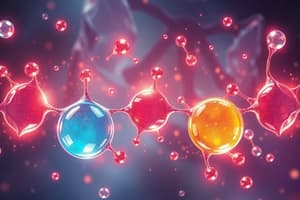Podcast
Questions and Answers
What is a characteristic reaction of carboxylic acids that involves the formation of an ester?
What is a characteristic reaction of carboxylic acids that involves the formation of an ester?
- Oxidation
- Esterification (correct)
- Hydrolysis
- Decarboxylation
Which reducing agent is commonly used for the reduction of carboxylic acids?
Which reducing agent is commonly used for the reduction of carboxylic acids?
- Hydrochloric acid
- Calcium hydroxide
- Potassium permanganate
- Sodium borohydride (NaBH4) (correct)
What is the primary result of the decarboxylation reaction of carboxylic acids?
What is the primary result of the decarboxylation reaction of carboxylic acids?
- Formation of an aldehyde
- Release of carbon dioxide (correct)
- Formation of a ketone
- Conversion to an alcohol
What effect does ionization have on the pH of solutions containing carboxylic acids?
What effect does ionization have on the pH of solutions containing carboxylic acids?
During the reaction of carboxylic acids with bases, what is primarily produced?
During the reaction of carboxylic acids with bases, what is primarily produced?
What is the product formed when a carboxylic acid reacts with an alcohol in the presence of an acid catalyst?
What is the product formed when a carboxylic acid reacts with an alcohol in the presence of an acid catalyst?
Which of the following statements is true regarding carboxylic acids?
Which of the following statements is true regarding carboxylic acids?
Which reagent is commonly used to reduce a carboxylic acid to a primary alcohol?
Which reagent is commonly used to reduce a carboxylic acid to a primary alcohol?
How can the Fischer esterification reaction be driven to completion?
How can the Fischer esterification reaction be driven to completion?
Which factor increases the acidity of carboxylic acids?
Which factor increases the acidity of carboxylic acids?
What occurs during saponification?
What occurs during saponification?
What happens to the carbon dioxide when a carboxylic acid reacts with sodium bicarbonate?
What happens to the carbon dioxide when a carboxylic acid reacts with sodium bicarbonate?
What type of intermediate is formed during Fischer esterification?
What type of intermediate is formed during Fischer esterification?
What is formed when a carboxylic acid reacts with another molecule?
What is formed when a carboxylic acid reacts with another molecule?
How are dicarboxylic acids named in terms of the parent alkane?
How are dicarboxylic acids named in terms of the parent alkane?
In naming carboxylic acids, what is the significance of the carboxyl group carbon?
In naming carboxylic acids, what is the significance of the carboxyl group carbon?
Which statement about the physical properties of carboxylic acids is true?
Which statement about the physical properties of carboxylic acids is true?
What effect do dimers have on the properties of carboxylic acids?
What effect do dimers have on the properties of carboxylic acids?
Which prefix is used to indicate the presence of an -OH substituent in carboxylic acids?
Which prefix is used to indicate the presence of an -OH substituent in carboxylic acids?
What is a common characteristic of fatty acids?
What is a common characteristic of fatty acids?
Which Greek letter is often used in the nomenclature of carboxylic acids for substituents?
Which Greek letter is often used in the nomenclature of carboxylic acids for substituents?
Flashcards
Carboxylic Acid Acidity
Carboxylic Acid Acidity
Carboxylic acids are weak acids, with pKa values generally between 4-5. Highly electronegative substituents near the carboxyl group increase acidity.
Carboxylic Acid + Base
Carboxylic Acid + Base
Carboxylic acids react with strong bases (like NaOH or KOH) to form water-soluble salts. They also react with weak bases like ammonia and amines.
Carboxylic Acid + Bicarbonate
Carboxylic Acid + Bicarbonate
Carboxylic acids react with sodium bicarbonate (or sodium carbonate) to form water-soluble salts and produce carbon dioxide gas.
Carboxylic Acid Reduction
Carboxylic Acid Reduction
Signup and view all the flashcards
Fischer Esterification
Fischer Esterification
Signup and view all the flashcards
Esterification Reversibility
Esterification Reversibility
Signup and view all the flashcards
Soap Formation (Saponification)
Soap Formation (Saponification)
Signup and view all the flashcards
Soap Micelles
Soap Micelles
Signup and view all the flashcards
Carboxylic Acid Functional Group
Carboxylic Acid Functional Group
Signup and view all the flashcards
Carboxylic Acid Derivatives
Carboxylic Acid Derivatives
Signup and view all the flashcards
IUPAC Naming (Carboxylic Acids)
IUPAC Naming (Carboxylic Acids)
Signup and view all the flashcards
Carboxyl Carbon Location
Carboxyl Carbon Location
Signup and view all the flashcards
Substituent Naming
Substituent Naming
Signup and view all the flashcards
Dicarboxylic Acid Naming
Dicarboxylic Acid Naming
Signup and view all the flashcards
Fatty Acids
Fatty Acids
Signup and view all the flashcards
Physical Properties of Carboxylic Acids
Physical Properties of Carboxylic Acids
Signup and view all the flashcards
Fatty Acid Structure
Fatty Acid Structure
Signup and view all the flashcards
Saturated Fatty Acid
Saturated Fatty Acid
Signup and view all the flashcards
Unsaturated Fatty Acid
Unsaturated Fatty Acid
Signup and view all the flashcards
Melting Point of Fatty Acids
Melting Point of Fatty Acids
Signup and view all the flashcards
Cis Double Bonds in Unsaturated Fatty Acids
Cis Double Bonds in Unsaturated Fatty Acids
Signup and view all the flashcards
Study Notes
Carboxylic Acids and Esters
- Carboxylic acids have a carboxyl group.
- The carboxyl group can be represented as -C-OH, -COOH, or -CO2H.
- Derivatives of carboxylic acids include anhydrides, esters, and amides.
- These derivatives are formed by reacting a carboxyl acid group with another molecule, resulting in the loss of water.
- Carboxylic acid IUPAC names use the longest carbon chain containing the carboxyl group as the parent alkane.
- The final '-e' in the parent alkane name is changed to '-oic acid'.
- Substituents, such as -OH (hydroxy) and -NH2 (amino), are included in the name.
Naming Carboxylic Acids
- The longest carbon chain containing the carboxyl group is identified as the parent alkane.
- The carboxyl carbon is always numbered 1.
- The name change is from -e of the parent chain to -oic acid.
Dicarboxylic Acids
- The suffix -dioic acid is added to name the parent alkane name.
- Carboxyl acid groups are at the chain ends; hence, no need to number them.
Examples of Carboxylic Acids
- Specific examples of carboxylic acids with their common and IUPAC names, their structures and derivations are listed.
Physical Properties of Carboxylic Acids
- Carboxylic acids contain three polar covalent bonds (C=O, C-O, and O-H).
- The polarity of the carboxyl group dictates physical properties.
- Carboxylic acids have higher boiling points than comparable organic compounds due to hydrogen bonding.
- Carboxylic acids are more soluble in water than alcohols, ethers, aldehydes, and ketones.
Fatty Acids
- Fatty acids are long-chain carboxylic acids.
- Derived from animal fats, vegetable oils, or phospholipids from biological membranes.
- Generally 12-20 carbons in an unbranched chain, often with an even number of carbons
- Can be saturated or unsaturated.
- Unsaturated fatty acids have lower melting points than saturated.
- Cis isomers of unsaturated fatty acids are common; trans isomers are less so.
Reactions of Carboxylic Acids
- Acid-Base Properties: Ionization and reaction with bases, esterification, reduction(using reagents like NaBH4 or LiAlH4). Decarboxylation
- Derivatives of Carboxylic Acids: Reaction with acids (anhydride formation) and with amines (amide formation).
Acidity of Carboxylic Acids
- Carboxylic acids are weak acids.
- Their Ka (acid dissociation constant) typically ranges from 10⁻⁴ to 10⁻⁵ for unsubstituted aliphatic and aromatic carboxylic acids.
- The pKa value indicates the pH at which half of the acid has lost its hydrogen.
- Highly electronegative substituents near the carboxyl group increase the acidity of carboxylic acids. Examples include -OH, -Cl, and -NH3+.
Reaction with Bases
- Carboxylic acids react with strong bases (NaOH, KOH) to form water-soluble salts (e.g., sodium benzoate).
- They also react with weak bases (amines) to form water-soluble salts.
- Acids also react with sodium bicarbonate and sodium carbonate to form water-soluble sodium salts and carbonic acid, which further decomposes to water and carbon dioxide.
Reduction
- Lithium aluminum hydride (LiAlH4) is a common reagent to reduce carboxylic acids to primary alcohols.
- The process is commonly carried out in diethyl ether.
Fischer Esterification
- Fischer esterification is a common method to make esters.
- Carboxylic acid reacts with alcohol in the presence of an acid catalyst (e.g., sulfuric acid).
- The reaction is reversible and can be controlled by altering the reaction conditions for the preferred product.
Soaps
- Natural soaps are made by boiling animal fats (like lard) with sodium hydroxide (saponification).
- Soap molecules in water form spherical clusters called micelles.
- Hydrophobic tails cluster inwards, while hydrophilic heads face the water.
- Soaps act as emulsifying agents, allowing them to clean dirt (grease, oil, and fat stains) removing them when mixed with water.
- Natural soaps form water-insoluble salts in hard water, due to the presence of divalent cations (Ca²⁺, Mg²⁺, Fe³⁺) in hard water.
Detergents
- Synthetic detergents overcome the precipitation problem in hard water by using sulfonic acid group (-SO₃) instead of the carboxyl group (-COOH).
- Calcium, magnesium and iron salts of sulfonic acids are more soluble in water compared to fatty acid salts.
- Synthetic detergents are primarily synthesized from linear alkylbenzene sulfonates (LAS).
Studying That Suits You
Use AI to generate personalized quizzes and flashcards to suit your learning preferences.




